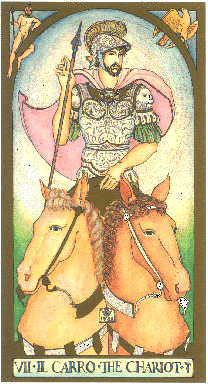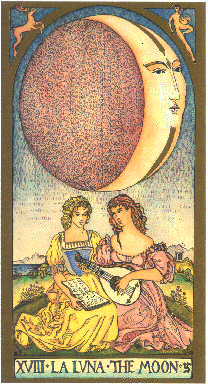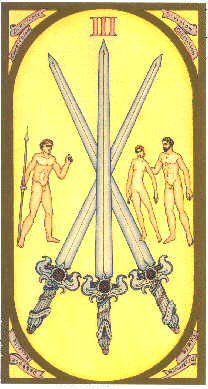|
|
 A Renaissance
Tarot A Renaissance
Tarot
- designer/artist/author: Brian
Williams
- publisher: US Games, Inc.
- first appeared: 1987
This is a very special deck. It is one of very few modern
decks that actually draws deeply from the 500-year-old
Italian roots of the tarot, rather than simply recycling
occultist speculations of more recent vintage. As the proud
owner of reproductions of several old Italian decks, I think
the Renaissance Tarot does an excellent job of bringing the
artistic and cultural feeling of those ancient decks into
the modern world. This is also a deck that celebrates
humanity: the human form, the human intellect, the human
spirit--all idealized in a way we seem to have almost
forgotten how to do.
First, the book. You can buy the deck separately, but
that would be missing a lot. Brian Williams's book is an
important piece of tarot in its own right, serving up a
much-needed art history perspective. The tarot is placed in
the artistic and literary context of the renaissance, with
many drawings and quotations. The drawings taken from
non-Tarot Renaissance art are especially appreciated. My
mother is an art history fan (without much academic
background), so we had all these great books around the
house when I was a kid. I'm thrilled that someone else has
pulled renaissance art and tarot together, as I doubt that I
would ever have found the time to do so. But what rewards!
It cuts right through a lot of the ignorance regarding the
tarot's origins. (And, incidentally, provides an eloquent
justification for some of Williams's own artistic
decisions.) I also enjoyed the literary citations. I'm one
of those freaks who actually kept taking Latin year after
year, against all the conventional wisdom of the land-grant
university I attended. This deck and book stir up some fond
memories.
Renaissance art, of course, was engrossed in both
classical and Christian themes. Williams works the classics
into his deck in two ways: correspondences are made between
the Olympian deities and the major arcana, and the number
cards of each suit depict sequential incidents from an
appropriate classical myth.
 The
Olympian deities are depicted with some subtlety in the
corners of the major arcana cards. It's not overwhelming,
but it's there if it interests you. I like the book's
discussion of classical deities with respect to the cards,
although, as Williams recognizes, it's a better fit in some
places than in others. I don't think it's fair to sever
Saturn from the Hermit. I'd rather have seen Vulcan left
dangling or put with the Hierophant. But all in all, very
nicely done. Makes me wonder if there might be a market in
this postmodern world for a non-tarot deck of Greek deities?
Some of them itch to crawl out of the corners and take
center stage. The
Olympian deities are depicted with some subtlety in the
corners of the major arcana cards. It's not overwhelming,
but it's there if it interests you. I like the book's
discussion of classical deities with respect to the cards,
although, as Williams recognizes, it's a better fit in some
places than in others. I don't think it's fair to sever
Saturn from the Hermit. I'd rather have seen Vulcan left
dangling or put with the Hierophant. But all in all, very
nicely done. Makes me wonder if there might be a market in
this postmodern world for a non-tarot deck of Greek deities?
Some of them itch to crawl out of the corners and take
center stage.
One major arcana card that initially rubbed me the wrong
way was The Fool. He seems young and show-offish, which is
not at all my image of the Fool. But to be fair, I've never
met a Fool image that I like. To me, the essence of the
archetype is King Lear's fool, who seems utterly real and
vivid when I read the play, but always completely wrong when
given visible form. Isn't that odd? He's neither old nor
young, neither humble nor proud . . . someone who stands
outside the whole drama and yet manages to remain unnoticed
by the dramatis personae. I'm sure that if I ever see the
Fool properly rendered, it will be some kind of mystic
experience for me. In the mean time, I guess I just take
what I can get. After some study of this deck, though, I
came to see Williams's rendition of the Fool in a different
light. He now strikes me as a sort of "royal housepet",
perhaps a renaissance Kato Kaelin, whose place in life is to
hang out in close proximity to people who can pay his way,
and appear attractive, entertaining, and amusing. Perhaps
this is how King Lear's fool got his start.
This is a good point to comment on the general feel
imparted by the personalities portrayed in the deck. It's a
great vibe! They're all quasi-aloof, like demigods intent on
their affairs, full of human concerns but keeping their
distance from the viewer. That's nice. They have dignity
without being statues. It's the linkage with the tradition
of renaissance art that makes this possible.
 My
favorite cards among the majors are the Sun and Moon.
Absorbing these cards was a wonderful experience. I buy
decks hoping to find that somewhere among all the
re-interpretations of traditional motifs will be a true
artistic insight, something that takes the energy of the
card and runs off with it in a way that enriches my
understanding of the whole tradition. The Renaissance Tarot
Sun and Moon cards did that for me. Here's how. My
favorite cards among the majors are the Sun and Moon.
Absorbing these cards was a wonderful experience. I buy
decks hoping to find that somewhere among all the
re-interpretations of traditional motifs will be a true
artistic insight, something that takes the energy of the
card and runs off with it in a way that enriches my
understanding of the whole tradition. The Renaissance Tarot
Sun and Moon cards did that for me. Here's how.
The Moon card depicts two women playing music; the Sun
depicts two men reading poetry. The first impression is that
of intimacy; both couples seem bound together with sensual
and emotional energy. The observation then led me to
thoughts of the psychological basis for homophobia in our
culture, which then zeroed in on one interesting factor: the
scariness of the isolation of the genders. The feeling of
exclusion a man feels when seeing women together, complete
among themselves, or vice versa. Heterosexual marriage is an
institution that serves (among many other functions) to
diffuse the anxiety regarding the alienation of the sexes.
(Men don't need to understand women, they can just marry
them instead!) Suddenly I understood a facet of my reaction
to the Moon card in other decks: it's a female thing--I
don't belong here. The two women sharing an intimate moment
of song and relaxation on this card brought home the point
from a very fresh angle.
Still reveling in this discovery, I took a look at the
Sun card and the parallelism with the Moon. What a coup!
Traditionally, the symbolism has been patriarchically
driven, so that it's natural for the moon to arouse these
feelings of alienation and gender mystery, while the sun
gets to be "clear as day", something no one would give a
second thought to. But right there these cards issue the
challenge. If the Moon is a "girl thing", then the Sun is a
"guy thing"--how about that, huh? I love it. Now at last we
have the Sun and Moon in the intricate, challenging kind of
parity they deserve. The Sun is not the answer to the
Moon--it's the other half of the same question.
After reading through the book and examining the deck
card by card a couple times, I tried a reading. I'm getting
so many decks these days, that I've taken to asking each one
what it is for. It's a good get-acquainted strategy. Oddly,
I can never seem to remember what spread I use to answer the
question from deck to deck, So I asked the Renaissance Tarot
using a standard three-card spread: 1 = body = the problem;
2 = mind = the process of addressing the problem; and 3 =
spirit = the nature of the solution. I got 1 = Three of
Swords; 2 = Knight of Coins and 3 = Seven of Swords.
The fist thing I noticed was the beauty of the spread.
I'd been studying the cards individually, but I was struck
by how nice they looked in a row. Lots of class and
elegance. Like an intentional triptych, rather than a rabble
of images. Impressive. The next thing I noticed was that the
swords are drawn differently on the three than on the seven.
How did I miss this before? The three has passionate,
idealistic swords, with those rubies glaring out at me; the
seven has exuberant, self-satisfied swords with plump little
pummels. This is the kind of stuff tarot enthusiasts live
for!
Well, I guess it's time to make a long story shorter. The
spread told me that the deck was ready to deal with grown-up
problems, with reliability and prowess. What a classy
resume: "Acting with the determination and acumen of the
knight of coins, I transform divided impulses into valiant
solutions". The deck and I exchanged proper bows at this
point. :) None of my other decks came up with swords in
answer to this question. But then there's that whole swords
= fire thing to work out. (Williams reverses the usual
association of staves and swords with fire and air. If I
just say swords = Achilles, then the deck and I are both
happy.)
 Now
with a little work with this deck under my belt, I think one
of the things I like most about it is the minors. The pips
take center stage, with little scenes from classical
mythology worked in around them. The vignettes and keyword
labels are available and yet unobtrusive. This is great.
It's a delicate balance. There's enough there to encourage
thinking about the mythic correspondences, but not so much
that it becomes mandatory. By the way, the whole idea of
relating the numbers of each suit to the scenes of a myth is
very creative, and very useful. (The Mythic Tarot, which was
designed independently at about the same time as the
Renaissance Tarot, also makes use of this idea.) Whatever
numerological system one uses for the minors, the jist of it
is to pick up on the rhythms of change that permeate human
life. What better source for this than literature? I'm
really surprised at how smoothly this idea works its way
through in this deck: the plots employed provide every bit
as much structure to the minors as do the occultist systems,
but they are more accessible, and less intrusive if you
choose to work a different way. This is a really valuable
Tarot innovation. Now
with a little work with this deck under my belt, I think one
of the things I like most about it is the minors. The pips
take center stage, with little scenes from classical
mythology worked in around them. The vignettes and keyword
labels are available and yet unobtrusive. This is great.
It's a delicate balance. There's enough there to encourage
thinking about the mythic correspondences, but not so much
that it becomes mandatory. By the way, the whole idea of
relating the numbers of each suit to the scenes of a myth is
very creative, and very useful. (The Mythic Tarot, which was
designed independently at about the same time as the
Renaissance Tarot, also makes use of this idea.) Whatever
numerological system one uses for the minors, the jist of it
is to pick up on the rhythms of change that permeate human
life. What better source for this than literature? I'm
really surprised at how smoothly this idea works its way
through in this deck: the plots employed provide every bit
as much structure to the minors as do the occultist systems,
but they are more accessible, and less intrusive if you
choose to work a different way. This is a really valuable
Tarot innovation.
I think of this deck as my "daylight tarot". Instead of
the occasionally creepy emphasis on the subconscious and the
occult found in many modern decks, this one exudes a
optimistic, humanistic clarity. The renaissance exalted the
human spirit above the fears of the night. So does the
Renaissance Tarot. Instead of a deck for candles and
incense, this one is for a sunny terrace on a summer's day.
This is a very substantial deck, in terms of art,
scholarship, and personal utility for me. Well done.
|